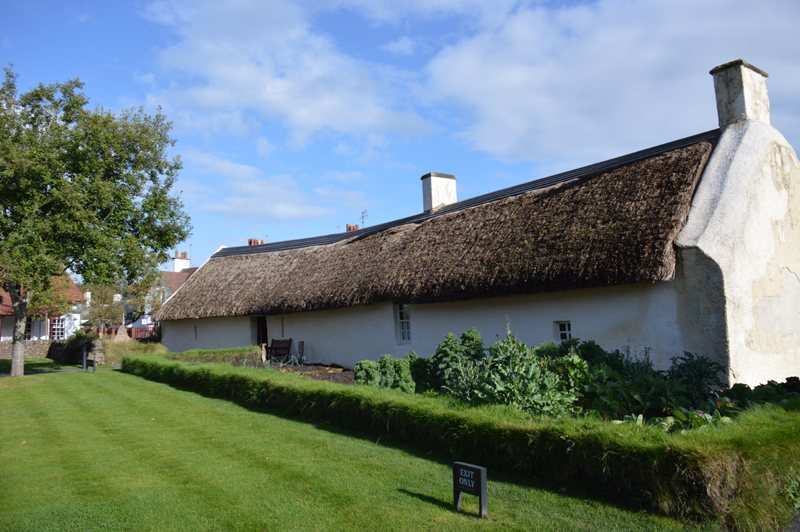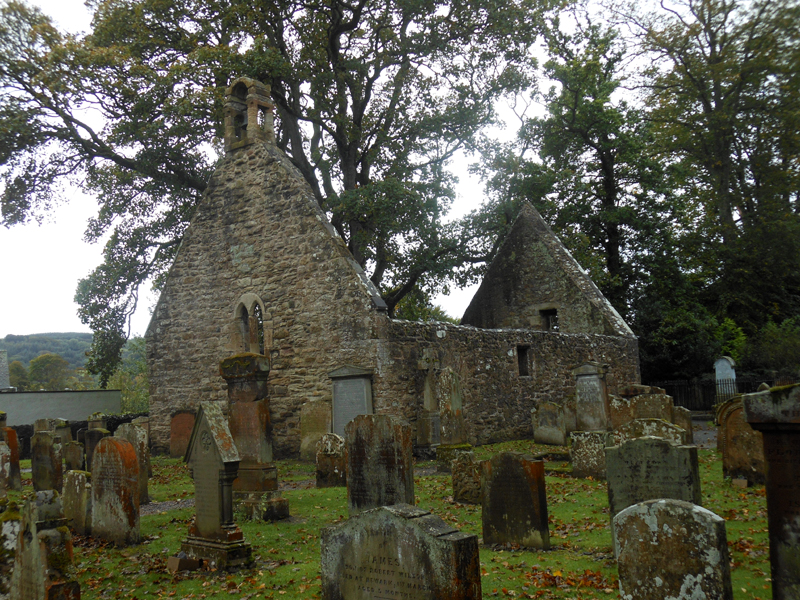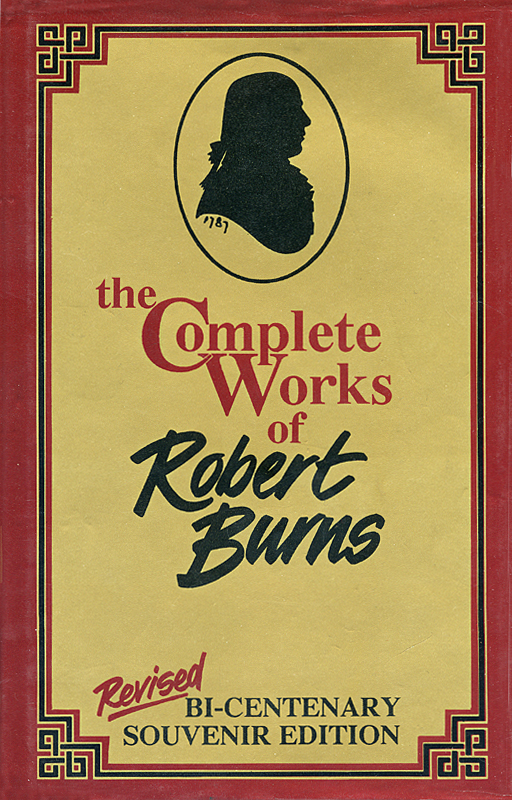
Bust of Robert Burns in Alloway Memorial © 2012 Scotiana
Today is a date not to be missed on the calendar for it is the anniversary of the birth of Robert Burns, the great national bard of Scotland whose poems are known and sung all over the world… so let us celebrate him with our Scottish friends to whom we wish a very very happy Burns Night !!!

A red rose in Robert Burns Memorial Gardens – Alloway © 2012 Scotiana
When we visited it, at the end of last September, the Robert Burns garden which shelters the poet’s big Memorial was still in bloom and we took a number of pictures of the many colourful varieties we found there. This beautiful red rose immediately conjured up the singing verses of ‘My Luve is like a red, red, rose ‘ , one of Robert Burns’s most popular poems.
I like very much to read the little comments which precede each poem in The Complete Works of Robert Burns, the Official Bicentenaray Edition first published by Alloway Publishing in 1986.
Here’s the comment for ‘My Luve is like a Red, Red Rose’ :
‘This is an amalgam of several old ballads and it illustrates Burns’s genius for reworking folk material and producing a poetic gem of the first rank. It was first published by Pietro Urbani in April 1794.’
My Luve is like a Red, Red Rose
by Robert Burns
O, my Luve’s like a red, red rose
That’s newly sprung in June;
O my Luve’s like the melodie
That’s sweetly play’d in tune.
As fair art thou, my bonnie lass,
So deep in luve am I:
And I will luve thee still, my dear,
Till a’ the seas gang dry:
Till a’ the seas gang dry, my dear,
And the rocks melt wi’ the sun:
I will luve thee still, my dear,
While the sands o’ life shall run.
And fare thee well, my only Luve
And fare thee well, a while!
And I will come again, my Luve,
Tho’ it were ten thousand mile.
I can’t help listening again and again to the poem so beautifully sung by the great Scottish artist Kenneth McKellar . I’ve noticed several differences between the text of the poem as it appears in The Complete Works of Robert Burns and the text sung by Kenneth McKellar.
Last year, for my birthday, my children offered me this box set of The Complete Songs of Robert Burns, recorded by Scotland’s finest traditional musicians and singers. No need to tell you how I treasure it 😉
It’s with great pleasure I listen again and again to ‘O my Luve’s like a red, red rose’ sung by Davy Steele and accompanied by Charlie McKerron (fiddle) and Tony McManus (guitar). GREAT INTERPRETATION !

Robert Burns Cottage from the garden in Alloway © 2012 Scotiana
Robert Burns was born on 25 January 1759 in the little rustic cottage we can still see today in the heart of the picturesque village of Alloway, about two miles south of Ayr, in southwestern Scotland.
He lived there for the first seven years of his life. We visited the poet’s native place last September. As it was a Sunday we had to make our way through crowds of tourists. The place is well worth the visit. Very lively scenes depict country life as it was at the time of Robert Burns, but they also conjured up happy memories of holidays spent at my grandmother’s farm when I was a child. Things have changed quite a lot since…
Robert Burn’s cottage is part of ‘The Robert Burns Heritage Trail’ which we only followed partly because of lack of time. There are so many places to visit in the area!
The Robert Burns Heritage Trail is a fascinating journey. The Burns National Heritage Park in Alloway and the National Trust for Scotland help preserve the cottages, townhouses, monuments and museums associated with Burns.
The best starting point is the Burns National Heritage Park in Alloway. You set off on a well signposted walking trail to enjoy the local sites. Burns Cottage was built in 1757 by Robert Burn’s father, William. It’s now a museum. The traditional But and Ben, a thatched clay cottage, has been renovated. You can see a documentary film that shows what life would have been like for Burns and his family.
There was a single room for living, cooking, eating, working and sleeping. There was an alcove box bed and pull-out cots on the floor at night-time. The livestock lived next door in the byre. Though poor, Robert’s parents ensured their children received a sound education, and encouraged them to enjoy reading, folklore and music.
The cottage’s annex houses the museum. There’s a fine collection of manuscripts, letters and artefacts. The poets, John Keats and William Wordsworth visited the cottage to pay homage to Burns.
http://www.scotland-placestovisit.com/twv//articles/217/1/The-Robert-Burns-Heritage-Trail-/Page1.html

Burns Cottage in Alloway – Street entrance © 2012 Scotiana
Like Shakespeare’s native house and Anne Hathaway’s Cottage in Straford-upon-Avon in England, the rustic whitewashed and thatched cottage built by Robert Burns’s father in 1757 has become a place of pilgrimage in Scotland.
Did you know that only a few days after the poet’s birth the cottage was partly blown down by a strong storm and that the family had to move in another place for some time… stormy beginnings to begin a stormy life 😉

The Robert Burns Trail in Alloway – ‘clinking glasses’ weathercock © 2012 Scotiana
In Alloway, we followed the path leading from the Museum to the Auld Kirk and to the Robert Burns Garden and Memorial. It is lined with very funny weathercocks illustrating Tam O’ Shanter, a long narrative and fantastic poem which the poet wrote when he was about 32.
The story narrated in Tam O’ Shanter takes place in the village Alloway (it must have been quite different then) and it depicts the adventures of Tam and Meg (his horse) on their way home after a few hours of good time spent by Tam in the local inn. It is late and they have to pass along the churchyard (just imagine how gloomy it must be in the middle of the night… but that didn’t seem to break the merry mood of the horseman, at least in the beginning 😉 and finally across the old bridge where poor Meg will pay the price of Tam’s light behaviour)…

The Robert Burns Trail in Alloway – weathercock ‘the witches scene’ after Tam O’ Shanter © 2012 Scotiana
Here’s a summary of Tam O’ Shanter I’ve found on Wikipedia:
‘Tam O’ Shanter’ tells the story of Tam, a farmer who gets drunk with his friends in a public house and then rides home on his horse Meg. On the way he sees the local haunted church lit up with witches and warlocks dancing and the devil playing the bagpipes.’

The Auld Kirk signpost in Alloway © 2012 Scotiana
‘He creeps into the churchyard to watch and on seeing a pretty witch in a short dress he shouts,`Weel done, cutty-sark!’. Having drawn attention to himself the dancing stops abruptly and the witches chase him and Meg to the River Doon’

A gloomy atmosphere in Alloway Auld Kirkyard © 2012 Scotiana
Kirk-Alloway was drawing nigh,
Whare ghaists and houlets nightly cry.—
…………………….
Alloway’s Church was drawing near,
Where ghosts and owls nightly cry.
(From ‘Tam O’ Shanter’ Scottish/English version)
‘The witches cannot cross the water but they come so close to catching Tam and Meg that they pull Meg’s tail off just as she reaches the bridge over the Doon. ‘

No witches on Brig O’ Doon © 2012 Scotiana
Here’s the subtitle and extremely interesting comment which precede ‘Tam O’ Shanter’ in The Complete Works of Robert Burns
A Tale
Of Brownyis and of Bogillis full is this Buke. – Gawin Douglas
‘Composed for Francis Grove to accompany an engraving of Alloway Kirk, and published in the second volume of Antiquities of Scotland in April 1791. It was written in fulfilment of a promise to Grove in 1789 but not carried out before the winter of 1790. In November that year Burns sent the first fragment to Mrs Dunlop. Grose received the complete poem at the beginning of December. Like ‘Halloween’ it draws heavily on the lore of witchcraft which Burns imbibed from Betty Davidson. The story is loosely based on the story of Graham of Shanter (1739-1811), whose wife Helen was a superstitious shrew. He was prone to drunkenness on market-day and on one such occasion the wags of Ayr clipped his horse’s tail – a fact he explained away by this story of witches which mollified his credulous wife.’ (The Complete Works of Robert Burns Alloway Publishing page 410)
I’ve also found the text of the poem online, in French and in English:
and last but not least a very good reading of it on You Tube:

Burns Monument and Memorial Gardens in Alloway © 2012 Scotiana
We lingered a long time in Robert Burns Gardens enjoying the nice weather (just after the rain… ) and visiting the Memorial. We’ll never forget the fragrance of the red red rose…
Bonne lecture !
A bientôt.
Mairiuna.

Red Rose © 2012 Scotiana




Leave a Reply